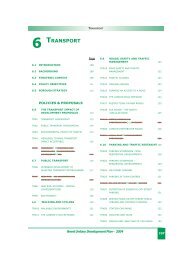Planning for Sport and Active Recreation Facilities ... - Brent Council
Planning for Sport and Active Recreation Facilities ... - Brent Council
Planning for Sport and Active Recreation Facilities ... - Brent Council
Create successful ePaper yourself
Turn your PDF publications into a flip-book with our unique Google optimized e-Paper software.
Chapter Seven Priorities <strong>for</strong> Future Provision<br />
• Football <strong>and</strong> jogging are the activities most participated<br />
in outdoors but these are below the London average<br />
• Cricket, dance studio based activities <strong>and</strong> basketball are<br />
more popular in <strong>Brent</strong> than across London as a whole<br />
• 87% of <strong>Brent</strong> pupils are receiving two hours quality PE<br />
• There are a low number of sports clubs <strong>and</strong> low sports<br />
club membership in <strong>Brent</strong>.<br />
Key facts – strategic context<br />
• Wembley is a host venue of the London 2012 Olympics<br />
<strong>and</strong> paralympics<br />
• <strong>Sport</strong> Engl<strong>and</strong> is aiming <strong>for</strong> 1 million people doing more<br />
sport by 2012.<br />
• <strong>Sport</strong> <strong>and</strong> leisure can play a role in achieving many of<br />
the <strong>Council</strong>’s corporate objectives <strong>and</strong> priorities<br />
• The Borough’s health <strong>and</strong> well being strategy recognises<br />
the need to increase the number of people participating<br />
in physical activity<br />
• Local regeneration masterplans recognise the need <strong>for</strong><br />
community infrastructure provisions<br />
Implications of key demographic <strong>and</strong> participation<br />
issues on future sports provision:<br />
• <strong>Sport</strong>s facilities will need to cater <strong>for</strong> <strong>Brent</strong>’s diverse<br />
multi cultural population to ensure all communities are<br />
able to participate.<br />
• Provision of public facilities in areas of greatest health<br />
inequalities <strong>and</strong> social deprivation is more likely to result<br />
in these communities participating in physical activity<br />
than if they had to travel a long way to a facility<br />
• A need <strong>for</strong> af<strong>for</strong>dable ‘pay <strong>and</strong> play’ activities in areas<br />
of greatest social need<br />
• <strong>Facilities</strong> need to be located in areas with very good<br />
public transport access <strong>and</strong> safe walking <strong>and</strong> cycling<br />
routes<br />
• <strong>Facilities</strong> targeting particular age groups should be<br />
focused in areas of greatest densities<br />
• <strong>Sport</strong>s facility provision needs to be backed up by<br />
significant sports development resources to target <strong>and</strong><br />
enable <strong>Brent</strong>’s residents to lead more active lifestyles<br />
• Better quality facilities will increase satisfaction levels<br />
<strong>and</strong> participation rates<br />
Key facts - <strong>Sport</strong>s <strong>Facilities</strong><br />
There has been very little investment in the Borough’s<br />
sporting infrastructure over the last twenty years. This<br />
now means that in general <strong>Brent</strong> has aging, poor quality<br />
sports facilities, low levels of satisfaction, low levels of<br />
provision in some facility types <strong>and</strong> some of the lowest<br />
levels of participation in London.<br />
• Over 50% of <strong>Brent</strong> residents live more than 20 minutes<br />
walk from any swimming pool<br />
• The current location of <strong>Brent</strong>’s sports centres meets<br />
local dem<strong>and</strong> but four of the five sports centres in <strong>Brent</strong><br />
are old <strong>and</strong> increasingly expensive to maintain<br />
• <strong>Sport</strong>s hall provision is almost adequate but the<br />
majority of facilities are old <strong>and</strong> located within schools<br />
• There is significant under provision of health <strong>and</strong> fitness<br />
facilities, both public <strong>and</strong> private<br />
• The quality of existing local authority pitches <strong>and</strong> courts<br />
needs to be improved<br />
• There is a need <strong>for</strong> changing accommodation on more<br />
pitch locations<br />
• MUGA provision should be focused in areas with higher<br />
densities of young people<br />
• Community access to sports facilities on school sites<br />
should be increased<br />
• Provision of specialist indoor sports provision should<br />
consider provision within neighbouring Boroughs <strong>and</strong><br />
local participation rates<br />
Future Facility Needs<br />
As a result of the extensive research, facility audits <strong>and</strong><br />
consultation, this strategy has reviewed <strong>and</strong> analysed<br />
future sports provision needs to satisfy current <strong>and</strong> future<br />
dem<strong>and</strong>.<br />
The following facility needs have been identified:<br />
<strong>Sport</strong>s Centres ‘Wet <strong>and</strong> Dry’<br />
Using <strong>Sport</strong> Engl<strong>and</strong>’s many strategic planning tools the<br />
audits highlight the importance of <strong>Brent</strong>’s existing sports<br />
centres, at or very near to their current locations, in<br />
providing much needed publicly accessible facilities <strong>and</strong><br />
meeting the sporting dem<strong>and</strong>s of <strong>Brent</strong> residents. The<br />
lack of swimming pool provision in <strong>Brent</strong> is a major issue<br />
88<br />
Chapter Seven - Priorities <strong>for</strong> Future Provision








![0702012-khat[1] - Brent Council](https://img.yumpu.com/11457346/1/184x260/0702012-khat1-brent-council.jpg?quality=85)








